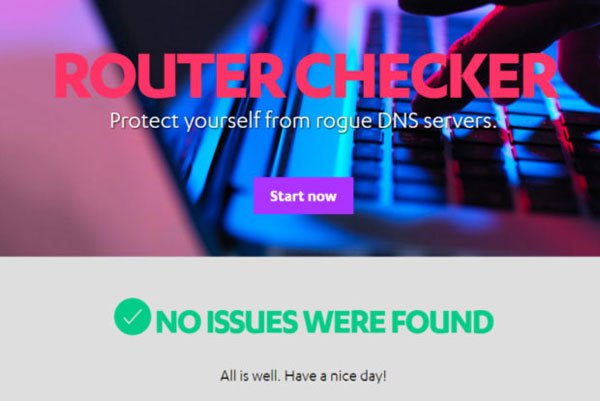Wireless Router Security Test With Just One Click
Wireless router security is one of the constant concerns of users, and it is the protection of the home Wi-Fi router. By Performing This Two-Second Test, You Can Ensure The Security Of Your Wi-Fi Network.
Wi-Fi routers are attractive targets for hackers. Once hacked, they can redirect your traffic to fake websites, steal your information, and spread malware. This simple online tool checks that the router is safe from DNS theft.
This happens more than you think. This router checker is one of the products of the security software company F-Secure Safe, which shows the efforts of hackers to change the settings of routers, computers, and phones to trick the user into going to malicious sites. F-Secure found more than 300,000 home and office routers hacked in 2014 alone.
Click the button to test the router, and the tool will check your server’s IP and DNS addresses to confirm they are correct. The site also contains that your traffic is connected to a secure server. Finally, we hope that everything is in order, and you will see the following figure:

Otherwise, you should reset the router settings to factory defaults, update the firmware, and take additional steps for network security, such as using WPA2 encryption and changing the router’s login password.
F‑Secure Router Checker Update & Wireless Router Security Tips
We’re excited to announce that the F‑Secure Router Checker is undergoing a significant refresh. We aim to enhance user experience and quality, making the tool even more valuable. We plan to release the newly improved Router Checker in 2025. In the meantime, here are some tips to help you optimize your router security.
Understanding How an Internet Router Works
An internet router is a crucial device that connects various devices to the internet. Instead of each device connecting directly to the internet, they connect to the router, which manages data flow to and from the connected devices. Whether computers, mobile devices, smart home appliances, entertainment systems, or gaming consoles, they all typically connect to the internet via a router, usually through a Wi-Fi network.
By managing all internet traffic, the router is vital in securing internet-connected devices from threats like hacking attempts and denial of service (DoS) attacks. Many routers come with additional safety features to enhance security. However, it’s essential to be aware of and prepared for potential threats to your router and the devices in your network.
What is DNS Hijacking?
DNS hijacking, or DNS redirection, is a threat involving the Domain Name System (DNS). Computers use number-coded addresses to connect to websites, but thanks to DNS, you only need to remember easy-to-use URL addresses. DNS automatically translates web addresses, allowing machines and humans to understand them.
In a DNS hijacking attack, cybercriminals hack into your router and hijack your DNS to redirect you to malicious websites. These sites may appear legitimate and secure but are designed to steal sensitive information, such as passwords and financial data, or infect your device with malware. DNS hijacking can also be used by internet service providers (ISPs) or third parties to display advertisements or limit certain functionalities.
Other Common Router Security Threats
DNS hijacking is one of many potential threats to your router’s security. Compromised devices, routers, and user accounts can pose significant risks to your personal information, online identity, and financial security. Some common threats include:
- Denial of Service Attacks (DoS): These attacks overwhelm your router with traffic, making it difficult for devices to connect to the internet and exposing them to further attacks.
- Malware: Malware can infect your router, alter DNS settings, or expose your devices to additional threats.
- Phishing: Cybercriminals use phishing attacks to trick victims into revealing valuable information or directing them to malicious websites.
Improving Your Router Security
Here are some practical steps to enhance the security of your router and connected devices:
- Firmware Updates: Regularly update your router’s firmware to fix vulnerabilities. Enable automatic updates to ensure you don’t miss any new updates.
- Disable Remote Management: Turn off remote management to prevent unauthorized access to your router.
- Check Router Settings: Avoid using default router settings, as they can be easier for criminals to exploit.
- Set Up a Guest Network: Create a guest network for visitors to avoid sharing your primary Wi-Fi credentials. Connect vulnerable IoT devices to the guest network to minimize risk.
- Use a Firewall: Enable the router’s built-in firewall for an extra layer of security.
- Use Strong Passwords: Use unique, complex passwords for your router and other accounts. Consider using a password manager to keep track of them.
Safety of Public Wi-Fi Connections
While a well-managed home Wi-Fi network is generally safe, public Wi-Fi networks can be risky. Public Wi-Fi networks, commonly found in cafés or during travel, may be monitored or controlled by cybercriminals. Consider using a VPN (Virtual Private Network) to browse safely on public Wi-Fi.
A VPN creates a secure tunnel that routes your traffic through a remote server, hiding your IP address and protecting your online activities from third parties, including cyber criminals. Using a VPN secures your connection to public Wi-Fi and offers additional protection at home by encrypting your data and shielding you from DNS hijacking.
